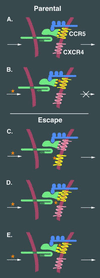HIV's response to a CCR5 inhibitor: I'd rather tighten than switch!
- PMID: 11854476
- PMCID: PMC122263
- DOI: 10.1073/pnas.042708299
HIV's response to a CCR5 inhibitor: I'd rather tighten than switch!
Figures


Comment on
-
HIV-1 escape from a small molecule, CCR5-specific entry inhibitor does not involve CXCR4 use.Proc Natl Acad Sci U S A. 2002 Jan 8;99(1):395-400. doi: 10.1073/pnas.012519099. Proc Natl Acad Sci U S A. 2002. PMID: 11782552 Free PMC article.
Similar articles
-
HIV receptors and cellular tropism.IUBMB Life. 2002 Apr-May;53(4-5):201-5. doi: 10.1080/15216540212652. IUBMB Life. 2002. PMID: 12120995 Review.
-
HIV type 1 chemokine coreceptor use among antiretroviral-experienced patients screened for a clinical trial of a CCR5 inhibitor: AIDS Clinical Trial Group A5211.Clin Infect Dis. 2007 Feb 15;44(4):591-5. doi: 10.1086/511035. Epub 2007 Jan 17. Clin Infect Dis. 2007. PMID: 17243065
-
Chemokine control of HIV-1 infection.Nature. 1999 Aug 19;400(6746):723-4. doi: 10.1038/23382. Nature. 1999. PMID: 10466720 No abstract available.
-
HIV chemokine receptor inhibitors as novel anti-HIV drugs.Cytokine Growth Factor Rev. 2005 Dec;16(6):659-77. doi: 10.1016/j.cytogfr.2005.05.009. Epub 2005 Jul 6. Cytokine Growth Factor Rev. 2005. PMID: 16005254 Review.
-
Determination of co-receptor usage of HIV-1.Methods Mol Biol. 2005;304:327-32. doi: 10.1385/1-59259-907-9:327. Methods Mol Biol. 2005. PMID: 16061986
Cited by
-
Persistence and emergence of X4 virus in HIV infection.Math Biosci Eng. 2011 Apr;8(2):605-26. doi: 10.3934/mbe.2011.8.605. Math Biosci Eng. 2011. PMID: 21631149 Free PMC article.
-
Genetic and phenotypic analyses of human immunodeficiency virus type 1 escape from a small-molecule CCR5 inhibitor.J Virol. 2004 Mar;78(6):2790-807. doi: 10.1128/jvi.78.6.2790-2807.2004. J Virol. 2004. PMID: 14990699 Free PMC article.
-
Shikonin, a component of chinese herbal medicine, inhibits chemokine receptor function and suppresses human immunodeficiency virus type 1.Antimicrob Agents Chemother. 2003 Sep;47(9):2810-6. doi: 10.1128/AAC.47.9.2810-2816.2003. Antimicrob Agents Chemother. 2003. PMID: 12936978 Free PMC article.
-
Naïve and memory cell turnover as drivers of CCR5-to-CXCR4 tropism switch in human immunodeficiency virus type 1: implications for therapy.J Virol. 2006 Jan;80(2):802-9. doi: 10.1128/JVI.80.2.802-809.2006. J Virol. 2006. PMID: 16378982 Free PMC article.
-
CD8+ T cell-mediated CXC chemokine receptor 4-simian/human immunodeficiency virus suppression in dually infected rhesus macaques.Proc Natl Acad Sci U S A. 2003 Sep 16;100(19):10977-82. doi: 10.1073/pnas.1933268100. Epub 2003 Sep 8. Proc Natl Acad Sci U S A. 2003. PMID: 12963814 Free PMC article.
References
Publication types
MeSH terms
Substances
LinkOut - more resources
Full Text Sources

